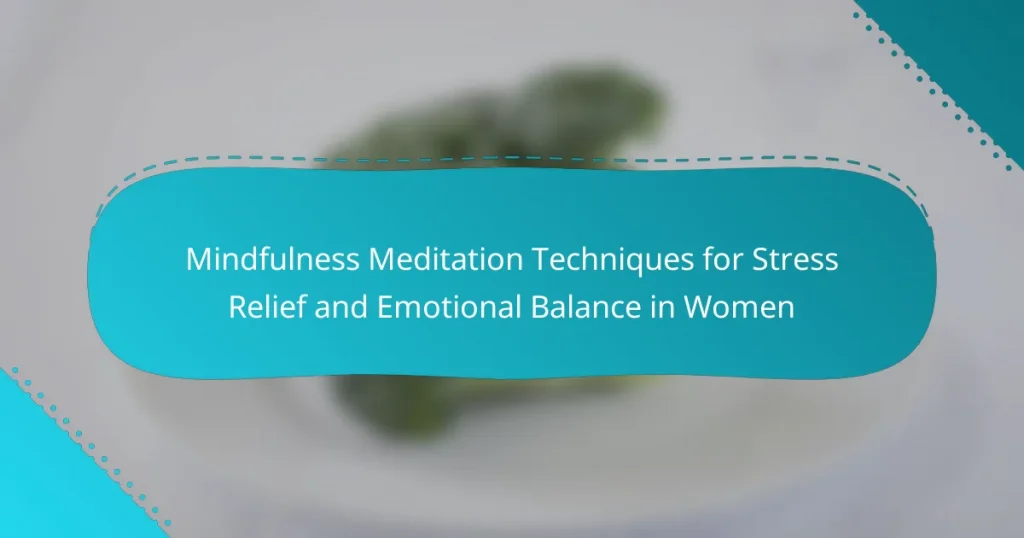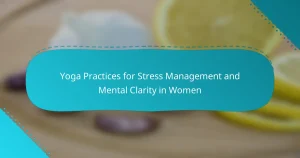Mindfulness meditation techniques offer effective stress relief and emotional balance for women. Focused breathing enhances relaxation, while body scan promotes deep tension release. Loving-kindness meditation fosters compassion and self-acceptance. Regular practice can significantly improve mental health and well-being.
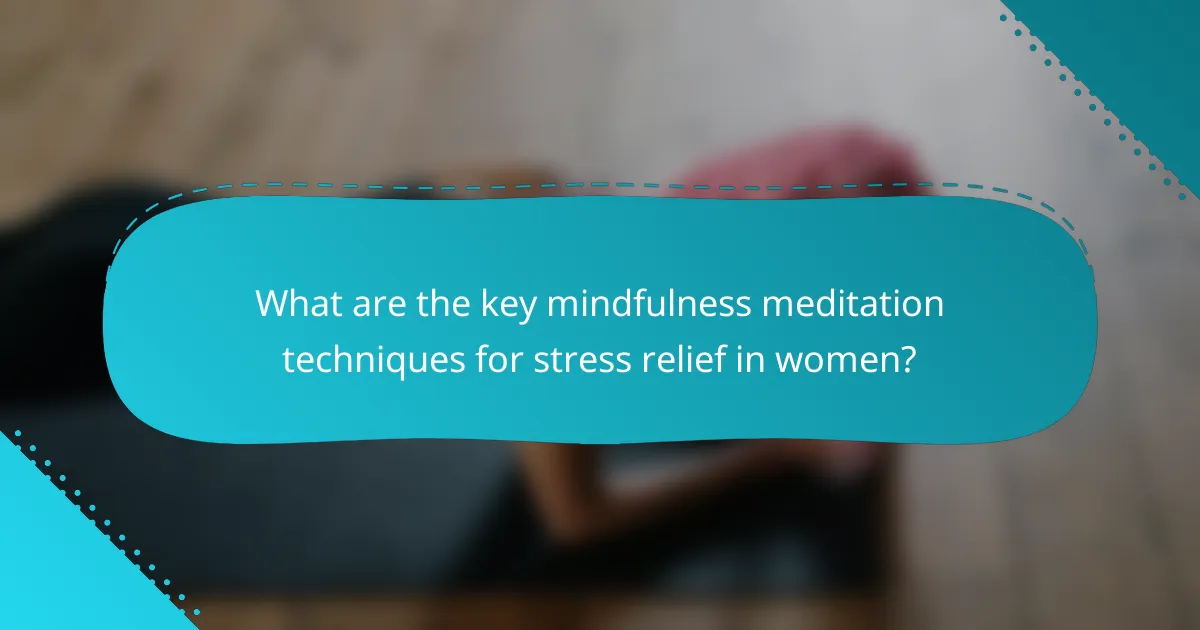
What are the key mindfulness meditation techniques for stress relief in women?
Mindfulness meditation techniques for stress relief in women include focused breathing, body scan, and loving-kindness meditation. These practices enhance emotional balance and reduce anxiety.
Focused breathing involves concentrating on the breath, promoting relaxation and awareness. Body scan encourages deep relaxation by directing attention to different body parts, helping to release tension. Loving-kindness meditation fosters compassion and self-acceptance, which can alleviate stress and improve emotional well-being.
Regular practice of these techniques can lead to significant improvements in mental health, making them valuable tools for women seeking stress relief.
How does mindfulness meditation enhance emotional balance?
Mindfulness meditation enhances emotional balance by promoting self-awareness and reducing stress. It helps women recognize their emotions without judgment, leading to healthier responses. Studies show that consistent practice can lower anxiety levels, improve mood, and increase overall emotional resilience. By focusing on the present moment, individuals can cultivate a sense of calm and clarity, which is essential for emotional stability.
What are the universal benefits of mindfulness meditation for women?
Mindfulness meditation offers universal benefits for women, including reduced stress, enhanced emotional balance, and improved overall well-being. It fosters self-awareness, allowing women to manage emotions effectively and cultivate resilience. Regular practice can lead to lower anxiety levels and increased focus, contributing to a more fulfilling life. Research indicates that mindfulness can also improve sleep quality, further supporting mental health.
How can mindfulness meditation reduce anxiety and stress?
Mindfulness meditation effectively reduces anxiety and stress by promoting emotional balance. It enhances self-awareness, allowing individuals to recognize and manage their thoughts and feelings. Research indicates that regular practice can lower cortisol levels, leading to reduced stress. Additionally, mindfulness techniques, such as focused breathing and body scans, can shift attention away from anxiety-provoking stimuli. This unique approach fosters resilience, empowering women to cope with daily stressors more effectively.
What role does mindfulness play in emotional regulation?
Mindfulness plays a crucial role in emotional regulation by enhancing awareness of thoughts and feelings. It allows individuals to observe their emotions without judgment, fostering a sense of calm. This practice can reduce anxiety and improve emotional resilience. Research indicates that mindfulness meditation techniques can lead to significant improvements in stress relief and emotional balance, particularly in women. By cultivating mindfulness, women can better manage their emotional responses and navigate challenging situations effectively.
What unique mindfulness techniques are particularly effective for women?
Mindfulness techniques like body scanning, loving-kindness meditation, and mindful walking are particularly effective for women. These practices foster emotional balance and reduce stress, addressing unique challenges faced by women.
Body scanning enhances body awareness and helps release tension. Loving-kindness meditation cultivates compassion and self-acceptance, which can be empowering. Mindful walking connects physical movement with mental presence, promoting relaxation and clarity. Each technique supports emotional well-being and resilience.
How can guided imagery enhance mindfulness practice?
Guided imagery can significantly enhance mindfulness practice by promoting relaxation and focus. This technique encourages visualization of calming scenarios, which can reduce stress and improve emotional balance. Research shows that integrating guided imagery into mindfulness meditation can deepen the experience and increase its effectiveness. Women practicing these combined techniques often report greater emotional resilience and a stronger sense of well-being.
What is the impact of loving-kindness meditation on emotional health?
Loving-kindness meditation significantly enhances emotional health by fostering compassion and reducing negative emotions. It promotes positive feelings and improves overall well-being. Research indicates that individuals practicing this technique experience lower levels of anxiety and depression, leading to increased emotional resilience. Regular engagement in loving-kindness meditation can also strengthen interpersonal relationships, contributing to a supportive social network.
What rare mindfulness practices are gaining popularity among women?
Mindfulness practices such as forest bathing and sound meditation are gaining popularity among women. These unique techniques promote emotional balance and stress relief through immersive sensory experiences. Forest bathing, or shinrin-yoku, encourages connection with nature, enhancing mental well-being. Sound meditation uses vibrations from instruments like singing bowls to foster relaxation and mindfulness. Both practices offer rare attributes that differentiate them from traditional mindfulness methods, appealing to women seeking holistic approaches to emotional health.
How can art-based mindfulness practices support emotional balance?
Art-based mindfulness practices enhance emotional balance by fostering self-awareness and creative expression. Engaging in activities like painting or sculpting allows women to process emotions and reduce stress. Studies show that creative outlets can lower cortisol levels, promoting a sense of calm. Additionally, these practices encourage present-moment awareness, helping individuals connect with their feelings without judgment. As a result, art serves as a unique tool for emotional regulation and resilience.
What are the benefits of nature immersion in mindfulness meditation?
Nature immersion enhances mindfulness meditation by reducing stress and promoting emotional balance. Engaging with natural environments fosters a sense of calm, increases attention span, and boosts overall well-being. Studies show that spending time in nature can lower cortisol levels, improving stress management. Additionally, the unique sensory experiences provided by nature, such as sounds and scents, deepen mindfulness practices, making them more effective for emotional regulation.
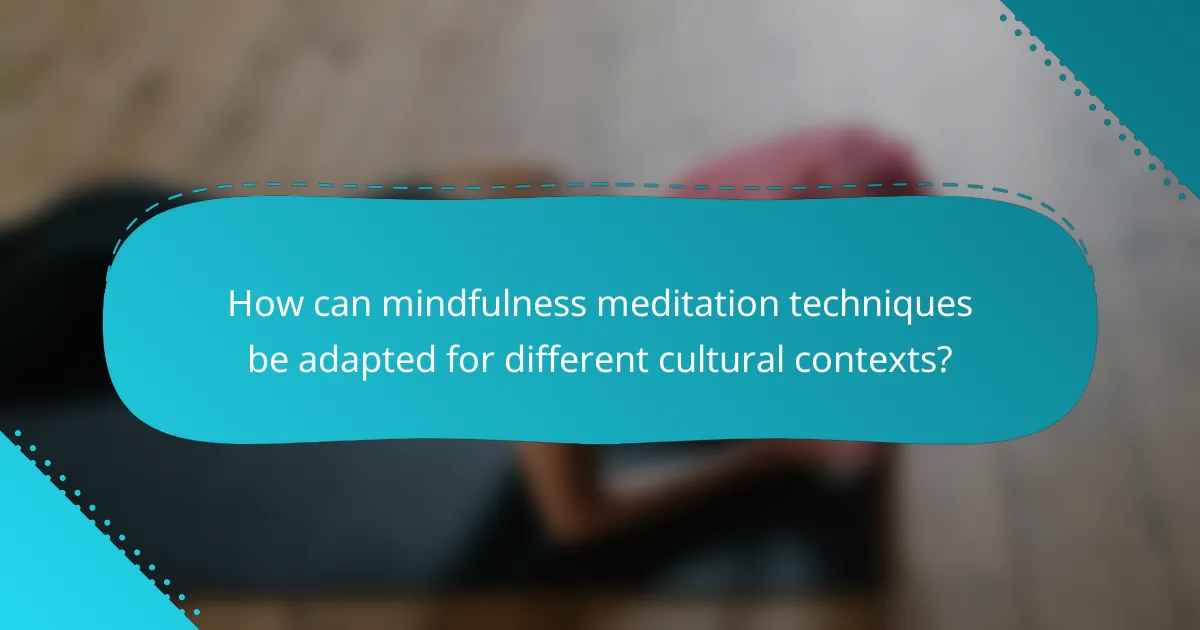
How can mindfulness meditation techniques be adapted for different cultural contexts?
Mindfulness meditation techniques can be effectively adapted to various cultural contexts by incorporating local practices and beliefs. This adaptation enhances relevance and acceptance among diverse groups.
For example, in Eastern cultures, techniques may emphasize community and collective well-being, while Western contexts might focus on individual stress relief. Integrating cultural narratives into mindfulness practices can foster deeper connections.
Additionally, using culturally specific symbols and language can make meditation more relatable. This approach respects unique cultural identities while promoting emotional balance and stress relief.
Research shows that culturally adapted mindfulness programs can improve participation and outcomes. Tailoring these techniques to fit cultural nuances ensures they resonate with participants, enhancing their effectiveness.
What mindfulness practices resonate with women in different regions?
Mindfulness practices that resonate with women vary significantly across regions. In North America, practices like guided meditation and yoga are popular for their accessibility and community aspects. In Asia, particularly in countries like Japan and India, traditional practices such as Zen meditation and Vipassana are favored, emphasizing deep introspection and spiritual growth. European women often gravitate towards nature-based mindfulness, integrating outdoor activities with meditation. In Africa, community-oriented practices that involve storytelling and sharing experiences are prevalent, fostering emotional connection and support. Each region’s unique cultural context shapes the mindfulness techniques that women find most effective for stress relief and emotional balance.
How can women integrate mindfulness into their daily routines?
Women can integrate mindfulness into their daily routines by practicing short meditation sessions, mindful breathing, and conscious awareness during everyday tasks. Start with five minutes of meditation each morning to set a positive tone. Use mindful breathing techniques throughout the day to reduce stress; focus on inhaling deeply and exhaling slowly. Incorporate mindfulness into activities like eating or walking by paying attention to sensations and surroundings. This approach fosters emotional balance and enhances overall well-being.
What are the best times of day for mindfulness meditation?
The best times for mindfulness meditation are early morning, lunch breaks, and before bed. Early morning sessions promote a calm start to the day, enhancing focus and emotional balance. Midday practices help alleviate stress accumulated throughout the morning. Evening meditation aids in winding down, preparing the mind for restful sleep. Consistently practicing at these times can maximize the benefits of mindfulness meditation, particularly for stress relief in women.
How can women create a supportive environment for mindfulness practice?
Women can create a supportive environment for mindfulness practice by fostering open communication and collaboration. Encouraging group sessions enhances accountability and motivation. Establishing a designated space for practice promotes consistency. Providing resources, such as guided meditations or workshops, supports individual growth. Sharing personal experiences builds community and connection.
What common mistakes should women avoid in their mindfulness journey?
Women should avoid common mistakes like setting unrealistic expectations, neglecting self-compassion, and skipping regular practice in their mindfulness journey. These pitfalls can hinder emotional balance and stress relief. Additionally, focusing too much on technique rather than experience can lead to frustration. It’s crucial to embrace the process and be patient with oneself.
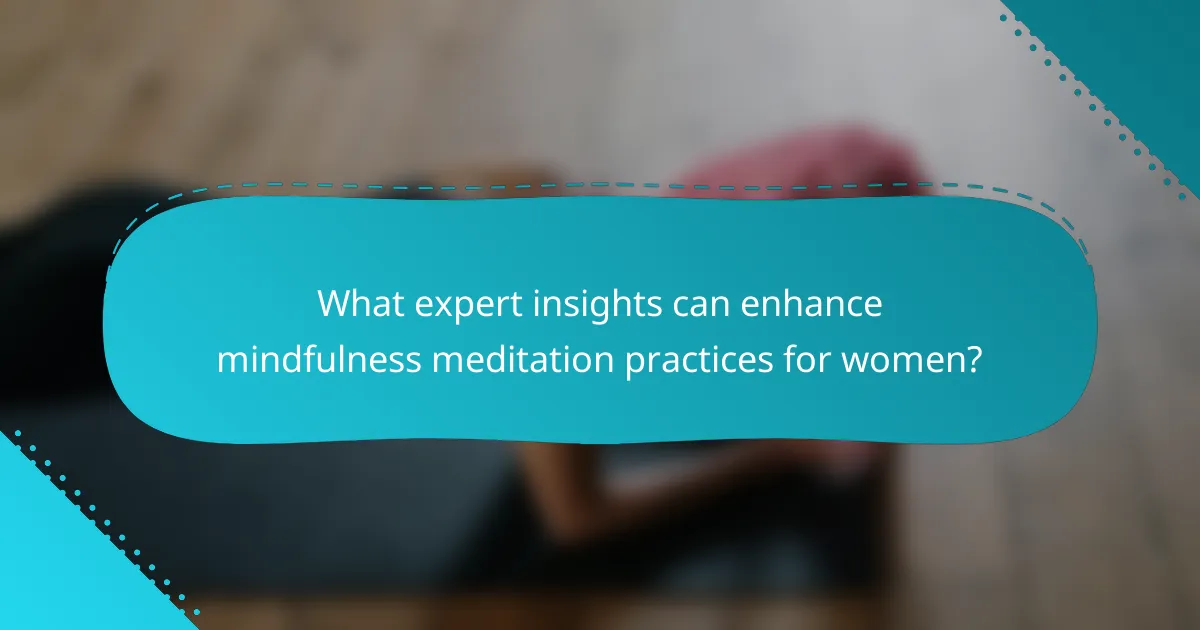
What expert insights can enhance mindfulness meditation practices for women?
Expert insights can greatly enhance mindfulness meditation practices for women by focusing on personalized techniques and community support. Tailoring practices to individual needs fosters deeper emotional connections and enhances stress relief. Research indicates that women often respond positively to group settings, which can create a supportive environment for shared experiences. Incorporating elements such as breath awareness and visualization can also improve emotional balance. Additionally, integrating self-compassion practices within meditation can uniquely empower women, promoting resilience and mental well-being.
How can women measure the effectiveness of their mindfulness practices?
Women can measure the effectiveness of their mindfulness practices by tracking emotional responses and stress levels over time. Regular self-assessment through journaling can reveal patterns in mood and stress, indicating progress. Additionally, using mindfulness scales, such as the Five Facet Mindfulness Questionnaire, can provide quantifiable insights into practice effectiveness. Engaging in consistent practice, such as daily meditation, can enhance emotional balance, leading to a more resilient mindset.
What are the best practices for sustaining a mindfulness meditation routine?
To sustain a mindfulness meditation routine, establish a consistent schedule, starting with short sessions and gradually increasing duration. Create a dedicated space free from distractions to enhance focus. Use guided meditations or apps for structure, and incorporate breathing techniques to deepen practice. Track progress to stay motivated and adjust practices based on personal needs.
